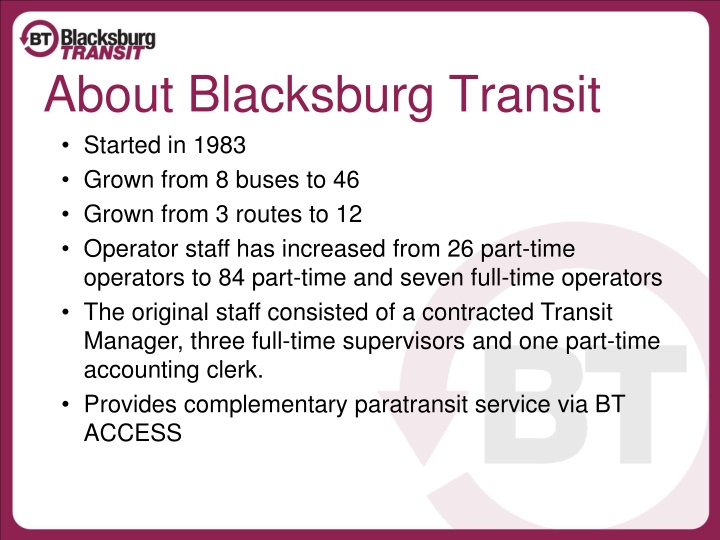
Blacksburg Transit: Evolution and Innovation in Public Transportation
Discover the transformation of Blacksburg Transit from its humble beginnings in 1983 to a comprehensive service with 46 buses and cutting-edge services. Learn about their growth, services, and initiatives such as the TIGGER Grant for sustainable practices and efficient operations.
Download Presentation

Please find below an Image/Link to download the presentation.
The content on the website is provided AS IS for your information and personal use only. It may not be sold, licensed, or shared on other websites without obtaining consent from the author. If you encounter any issues during the download, it is possible that the publisher has removed the file from their server.
You are allowed to download the files provided on this website for personal or commercial use, subject to the condition that they are used lawfully. All files are the property of their respective owners.
The content on the website is provided AS IS for your information and personal use only. It may not be sold, licensed, or shared on other websites without obtaining consent from the author.
E N D
Presentation Transcript
About Blacksburg Transit Started in 1983 Grown from 8 buses to 46 Grown from 3 routes to 12 Operator staff has increased from 26 part-time operators to 84 part-time and seven full-time operators The original staff consisted of a contracted Transit Manager, three full-time supervisors and one part-time accounting clerk. Provides complementary paratransit service via BT ACCESS
TIGGER Open House November 15, 2013
Operations Types of Service include: Fixed, Deviated-Fixed and Demand Response 46 buses in the fleet Provides 3.5 million passenger trips per year 90% Students; 5% Staff & Faculty; 5% Non-VT
What is ITS? The use of advanced applications which, without embodying intelligence as such, aim to provide innovative services relating to different modes of transport and traffic management and enable various users to be better informed and make safer, more coordinated and smarter use of transport networks.
TIGGER Grant Overview TIGGER Transit Investment in Greenhouse Gas and Energy Reduction BT received a $1.85 million grant from DOT and FTA to conduct a study. BT and VTTI are partnering to complete this study on the effects of Dynamic Bus Routing and Scheduling to conserve fuel and provide better customer service.
What is the TIGGER Grant? Collect data at stop-level to build a better picture of demand in close to real-time. Proactive vs. Reactive Will be able to predict when additional buses will be needed before the need arises.
Project Scope Project Planning develop schedule, routing model development and implementation. Data collection evaluation and selection of methods and hardware for data collection. Develop specs for equipment Procure equipment Install Design software applications Collect data
Project Scope Contd Data analysis and modeling algorithm development Model calibration and finalization to be tested during pilot implementation Implementation and testing of the routing/scheduling plan Pilot implementation Revisions of optimization model System-wide implementation
Reason for Study To see if it is possible to use dynamic routing to: Reduce CO2 gases/fuel usage Enable a more efficient transit system Increase customer satisfaction
Objectives Use a test route to collect real-time passenger data Use data to create a communication path for customers and buses Have buses only being used when there is a need (to cut down on Trippers and empty buses). Reinventing Transit Operations Making a Greener Planet Cutting Edge National Research
What is BT4U? BT4U is BT s new text messaging program that allows bus customers to use their cell phone to receive up to the next three scheduled departure times for an individual stop. Phone Web Text
Live Map Select your route
BT4U Text Users send a text message with the stop code and number and receive up to the next 3 departure times.
